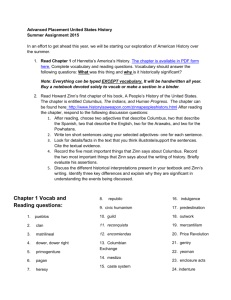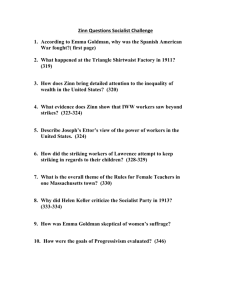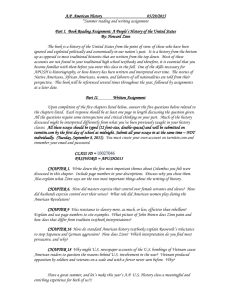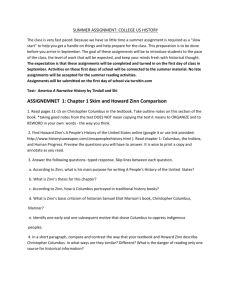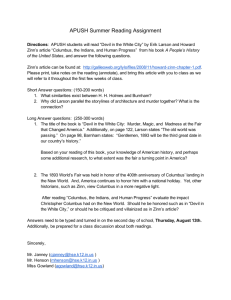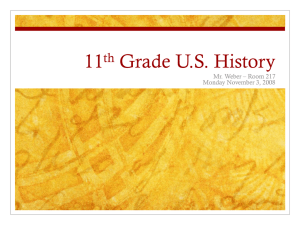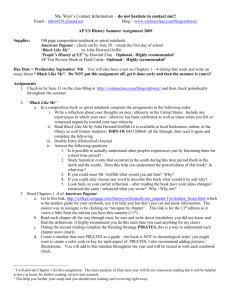mr prices apush summer assignment
advertisement
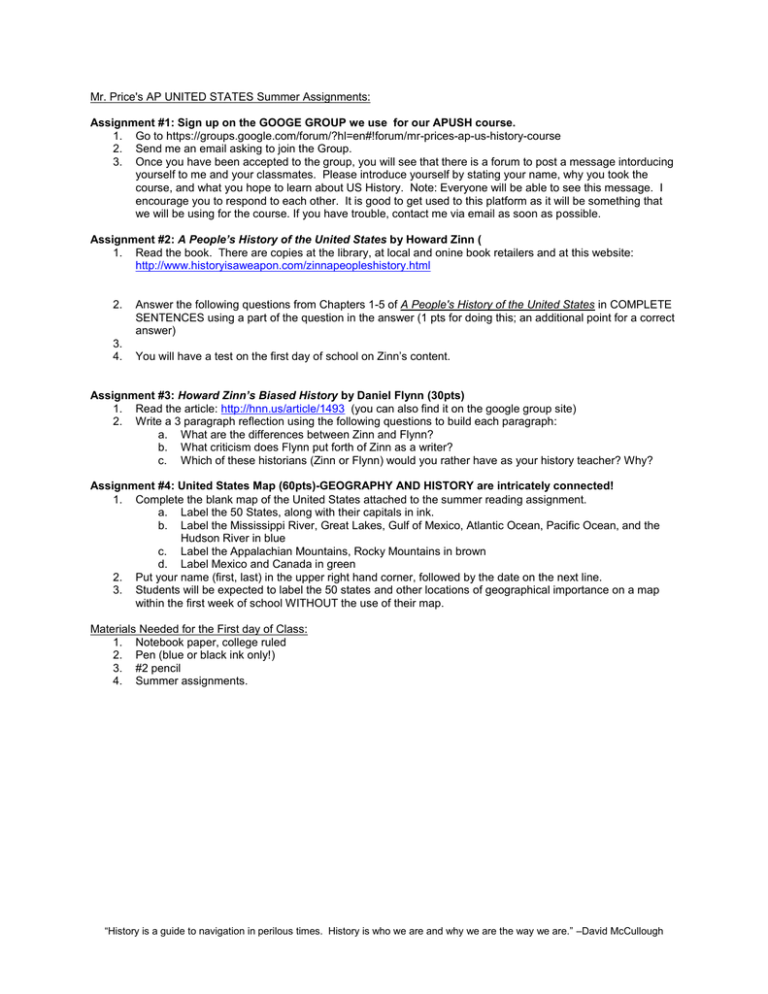
Mr. Price's AP UNITED STATES Summer Assignments: Assignment #1: Sign up on the GOOGE GROUP we use for our APUSH course. 1. Go to https://groups.google.com/forum/?hl=en#!forum/mr-prices-ap-us-history-course 2. Send me an email asking to join the Group. 3. Once you have been accepted to the group, you will see that there is a forum to post a message intorducing yourself to me and your classmates. Please introduce yourself by stating your name, why you took the course, and what you hope to learn about US History. Note: Everyone will be able to see this message. I encourage you to respond to each other. It is good to get used to this platform as it will be something that we will be using for the course. If you have trouble, contact me via email as soon as possible. Assignment #2: A People’s History of the United States by Howard Zinn ( 1. Read the book. There are copies at the library, at local and onine book retailers and at this website: http://www.historyisaweapon.com/zinnapeopleshistory.html 2. 3. 4. Answer the following questions from Chapters 1-5 of A People's History of the United States in COMPLETE SENTENCES using a part of the question in the answer (1 pts for doing this; an additional point for a correct answer) You will have a test on the first day of school on Zinn’s content. Assignment #3: Howard Zinn’s Biased History by Daniel Flynn (30pts) 1. Read the article: http://hnn.us/article/1493 (you can also find it on the google group site) 2. Write a 3 paragraph reflection using the following questions to build each paragraph: a. What are the differences between Zinn and Flynn? b. What criticism does Flynn put forth of Zinn as a writer? c. Which of these historians (Zinn or Flynn) would you rather have as your history teacher? Why? Assignment #4: United States Map (60pts)-GEOGRAPHY AND HISTORY are intricately connected! 1. Complete the blank map of the United States attached to the summer reading assignment. a. Label the 50 States, along with their capitals in ink. b. Label the Mississippi River, Great Lakes, Gulf of Mexico, Atlantic Ocean, Pacific Ocean, and the Hudson River in blue c. Label the Appalachian Mountains, Rocky Mountains in brown d. Label Mexico and Canada in green 2. Put your name (first, last) in the upper right hand corner, followed by the date on the next line. 3. Students will be expected to label the 50 states and other locations of geographical importance on a map within the first week of school WITHOUT the use of their map. Materials Needed for the First day of Class: 1. Notebook paper, college ruled 2. Pen (blue or black ink only!) 3. #2 pencil 4. Summer assignments. “History is a guide to navigation in perilous times. History is who we are and why we are the way we are.” –David McCullough Chapter 1: Columbus, the Indians, and Human Progress 1. How did the Arawaks greet Columbus and his men? (Use the excerpts from Columbus’ journal) 2. What were the Arawaks known for and why was this remarkable to the Europeans? 3. Why had the Spanish monarchs financed the Columbus expedition? 4. How did gold earrings lead to the Arawak’s downfall? 5. Evaluate the ways that Columbus attempted to pay back his dividends. 6. What way(s) did the Arawaks fight Columbus’ actions? 7. What were encomiendas? 8. Who was Bartolome de las Casas and his significance? 9. Describe the treatment of women in the Arawak culture? 10. Explain Zinn’s statement of, “Total control led to total cruelty.” 11. Why is Zinn critical of “Columbus Day”? 12. Why is Zinn critical of Harvard Historian Samuel Eliot Morison? 13. How does Zinn argue that past historians (and teachers!) have justified Columbus’ genocide of the Arawaks? 14. What “lens of history” does Zinn examine history through? Which “lens” does he avoid? Why does he feel this is necessary? 15. Describe Cortes’ conquest of the Aztecs. 16. Describe Pizzaro’s conquests. 17. How were the English colonial settlements similar to that of the Spanish? 18. How did the Pilgrims and Puritans respond to the “Indian problem”? 19. What was the Pequot War? 20. What, does Zinn argue, is the sacrifice of human progress? 21. Describe the Native American peoples of the North and South American continent that Columbus considered “inferior”. Chapter 2: Drawing the Color Line 22. What is significant about J. Saunders Redding’s description of the arrival of a ship in 1619? 23. How did slavery develop? How did racism develop along with it? 24. What elements of helplessness led to the Africans continued enslavement? 25. Describe the African civilization during the time of colonization. 26. Describe the conditions on a slave ship. 27. Describe the treatment of slaves early in the colonies. 28. Describe slave resistance. 29. What did slave owners consistently avoid? What methods did they use to avoid it? 30. When was the first large scale slave revolt? Why was it significant? 31. Why was it feared that whites would join slave revolts? How was this prevented? Chapter 3: Persons of Mean and Vile Condition 32. Describe Bacon’s Rebellion 33. How did Bacon’s Rebellion come to symbolize the class struggle, even though Bacon himself was a part of the wealthy class? 34. How were people oppressed in colonial Virginia? 35. How was the indentured servants Atlantic crossing similar to that of the slave? 36. Describe the conditions indentured servants endured. How did the indentured servants rebel? 37. Describe how the “mother country’s” class system was established and preserved in the colonies. 38. What happened on May 19, 1713? 39. What caused Britain to raise taxes that resulted in higher unemployment and poverty? 40. Why was there a desire to appease the poor whites? 41. What combination did the wealthy white planters fear? How did Bacon’s Rebellion realize this fear? 42. How did the consequences for Bacon’s Rebellion differ? What was the hope of these consequences? “History is a guide to navigation in perilous times. History is who we are and why we are the way we are.” –David McCullough Chapter 4: Tyranny is Tyranny 43. What was “discovered” around 1776? 44. Who were the colonists’ two enemies? How did the colonists see the Proclamation of 1763 uniting these two forces? 45. Describe the various land riot movements. What does this indicate about colonial society? 46. How did North Carolina suffer from class war? 47. Who were the loyal nine? What was their intent? 48. What happened on March 5, 1770? Who was Crispus Attucks? 49. What societal group made up the Sons of Liberty? How does this support Zinn’s argument that the Revolution was fought for the wealthy? 50. How was Patrick Henry able to unite the different classes towards war with England? 51. How did Thomas Paine use Common Sense to unite the people? 52. What did North Carolina send to the Continental Congress in May of 1776? 53. Who was left out of the Declaration of Independence, 1776? 54. Explain the circumstances around the phrase, “Tyranny is tyranny let it come from whom it may.” Chapter 5: A Kind of Revolution 55. How was the American Revolution won? 56. What motivated a wounded American lieutenant, as interviewed by Peter Oliver? 57. What battles did the Americans lose? Which did they win? 58. What was the turning point in the Revolution? Why? 59. When did the Revolution end? 60. Why was there rebellion within the Americans troops? How did General Washington respond? 61. How did religion play a role in the American Revolution? 62. What did not change as a result of the Revolution? 63. Why had the Indians joined the French in the French and Indian War? 64. Why had the Indians joined the British in the American Revolution? 65. What happened at Fallen Timbers? What was the Treaty of Grenville? 66. How could one argue that the abolitionist movement started during the Revolutionary War? 67. How did a strong central (federal) government help the already wealthy? 68. Describe Daniel Shay’s rebellion. 69. What were the intentions of the Riot Act? 70. What problem was rooted in democracy post-Revolutionary War? 71. How does the intent and interpretation of the Constitution change when seen through the light of economic interests? 72. Why was the Bill of Rights so important? 73. How was the First Amendment violated under John Adams’ administration? 74. According to Hamilton, who must the government align itself with? What tax was placed upon the poor? “History is a guide to navigation in perilous times. History is who we are and why we are the way we are.” –David McCullough “History is a guide to navigation in perilous times. History is who we are and why we are the way we are.” –David McCullough
